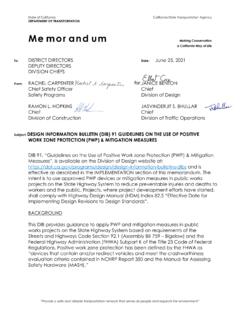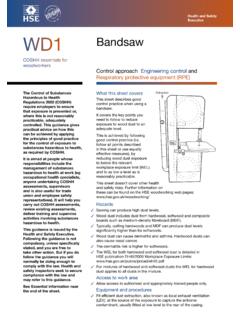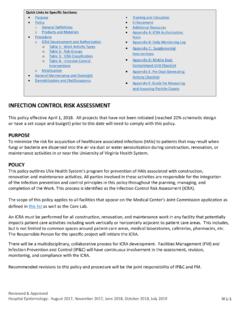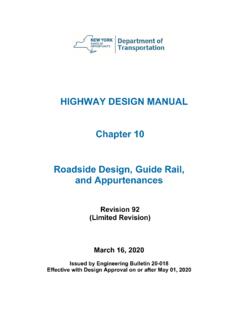Transcription of PLANNING CROWD CONTROLPLANNING CROWD CONTROL …
1 PLANNING CROWD ControlFor Your CROWD CONTROLPLANNING CROWD CONTROLPLANNING CROWD CONTROL FOR YOUR EVENT 3 IntroductionAs the size of public and special events grows, the PLANNING role becomes more difficult for event organizers. In addition to making basic preparations for an event, organizers must also take public safety and security needs into consideration and be prepared to respond to anything that jeopardizes the safety and welfare of the attendees and staff. To minimize risks, organizers must maintain sufficient safety precautions which are appropriate for the number of people attending the event. The bigger the event, the larger the security needs. Because of injuries and deaths which have occurred at various events, event organizers are open to a new level of risk and liability.
2 The ability to manage and CONTROL the people at any event, large or small, is make-or-break factor in special events PLANNING . Using effective principles, event coordinators can properly manage and CONTROL attendees and increase their chances of hosting an event free of safety problems. To create a successful CROWD management plan, a thorough analysis is needed of these factors: The type of event The attributes of the facility or location The size and makeup of the CROWD Entry and exit points Communications Effective CROWD CONTROL practices and toolsEffective CROWD management occurs throughout the event, from pre-event to post-event. Prior to the event, advanced PLANNING and training are needed.
3 During the event, organizers focus on handling the internal and external crowds and providing security. After the event, responsible parties should regroup and document the lessons learned in order to plan for future purpose of this white paper is to provide information that will help event planners and organizers create an effective CROWD CONTROL management plan. This paper will provide an overview of CROWD management practices, explore the use of CROWD CONTROL barriers and related products, and look at case studies of successful CROWD management at major CROWD CONTROL FOR YOUR EVENT 4 The CROWD Management PLANNING Process Creating a CROWD management plan, and identifying the appropriate tools to carry out that plan, is critical for the success of an event.
4 The International Association of Venue Managers identifi ed the CROWD management plan as a crucial part of any risk management event PLANNING process encompasses more than just ensuring that people are having a good time. Organizers plan every detail of an event basic layout, structural installations, security, ticketing, parking, entry and exit points, and event organizer can craft a well-suited CROWD management plan by following the principles established by other event organizers, and by accurately assessing the scope of the event, the threats posed to attendees, and the impact on the surrounding community. PLANNING should incorporate consideration and understanding of the following: Event type (concert, charity event, political rally, etc.)
5 Location (indoor, outdoor, urban or rural) CROWD size and demographics Architectural and environmental concerns (seating, perimeter fencing, and barricades) Security concerns Entrance and exit points Vehicle entrances and parking Ticketing processes Restroom facilities Concession needsPlanners can employ different strategies and tactics to address each of these areas. The nature of the event will dictate which CROWD management products should be employed. Strategies for a charity run will be much different than those for a national political event. Indoor events will have different requirements than outdoor single most complicating factor for any event is the CROWD .
6 A top priority for any organizer is to identify and minimize the potential risks posed by and to event attendees. The potential for human loss, as well as economic loss, make this a serious concern. The ability to direct the movement of the attendees throughout the venue, with the goal of mitigating personal harm and property loss, is accomplished through effective CROWD management. Pre-event planningCrowd management begins long before any person enters the facility or location. All staff associated with the event should be well-trained on security measures and CROWD management requirements. Staff should be given protocols and manuals for guidance. The guidelines should provide information on the building s layout, entry and exit procedures, rules of the venue, safety instructions, and evacuation plans.
7 A chain of command should be laid out to include public safety staff and event staff inside and outside the event. Communication plans should also be provided to ensure that the lines of communication remain open for all staff during the CROWD CONTROL FOR YOUR EVENT 5 The entrance Before the patrons enter the event, the entrance process should be well defined to ensure smooth entry. It is important to lay out the plan for how attendees will be kept outside of the event before it starts. If the event is inside a facility, locked doors or blocked or roped off entrances keep patrons from entering. If the event is outdoors, perimeter security becomes a factor and requires adequate measures to keep people out, including fencing and gates.
8 Entry times should be posted well in advance to let attendees know what to expect the day of the event. Depending on the size of the CROWD , attendees may need to be queued up for entrance to the event. The entrance process can be handled with relative ease by the use of a queuing system, such as a stanchion and belt system. If attendance numbers need to be monitored, turnstiles can be used to keep an accurate extra entrances can minimize the CROWD size and wait times. Additional measures needed for the comfort of the guests including restroom facilities, water stations, and refreshments should be The Department of Justice s Office of Community Oriented Policing Services issued guidelines for traffic PLANNING in its publication PLANNING and Managing Security for Major Special Events: Guidelines for Law Enforcement.
9 Among its recommendations, effective traffic CONTROL was cited as a key PLANNING point. CROWD CONTROL at Retail Store Special EventsSpecial promotions and events at retail stores often create an elevated safety risk level, both for customers and employees. In 2010, the Occupational Safety and Health Administration (OSHA) issued guidelines for retailers to use for CROWD management in response to injuries and deaths that occurred during sales and promotional events around the country. OSHA CROWD CONTROL recommendations include the proper use of barricades or rope lines to manage the entry and exit of customers and to create safety zones within the store. The National Retail Federation (NRF) also issued a set of guidelines for effective CROWD management in 2010.
10 In its guide, Effective CROWD Management, Guidelines on how to maintain the safety and security of your customers, employees and store, the NRF cited the importance of setting up barriers and stanchions in key spots throughout the store. These measures help avoid congestion and minimize the potential for personal injury and property damage. PLANNING CROWD CONTROL FOR YOUR EVENT 6 Outside the venue or event, provisions must be made for vehicular entry and parking, including signage and staff to help direct traffic flow. Vehicle traffic can be directed through a series of channelized Facility maintenance, and exit proceduresplastic barriers and ushered into appropriate parking spots by event staff.







